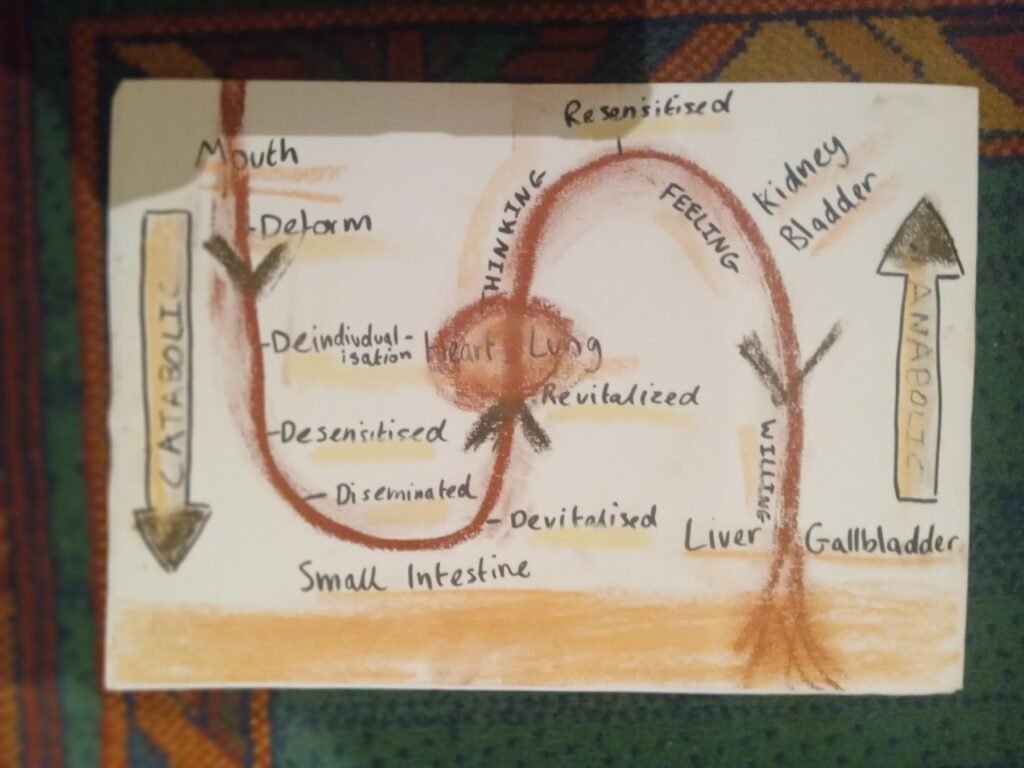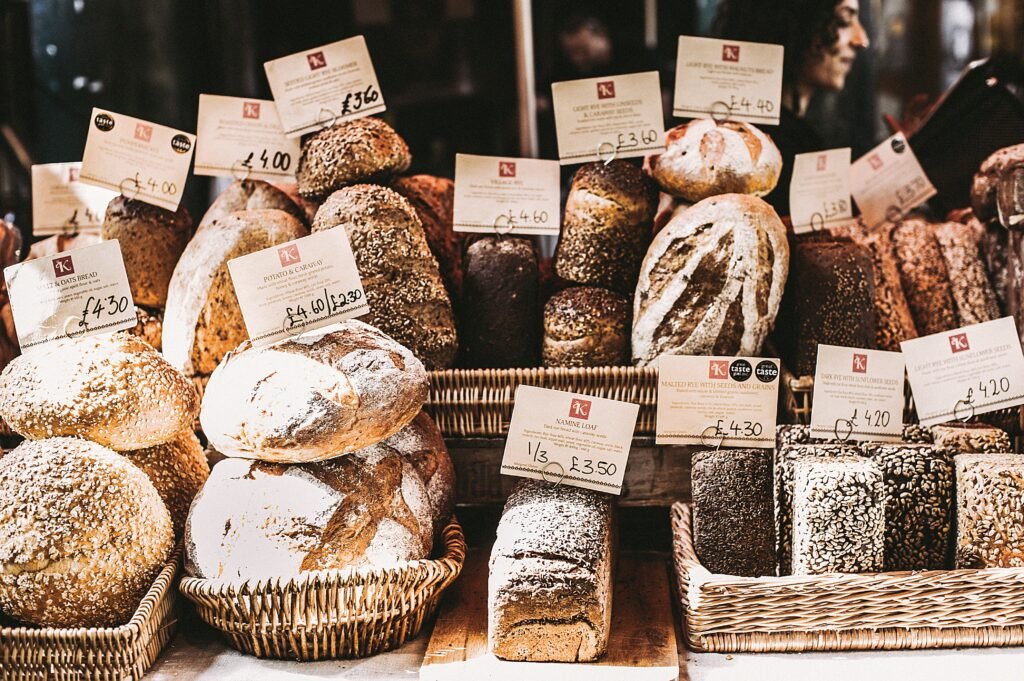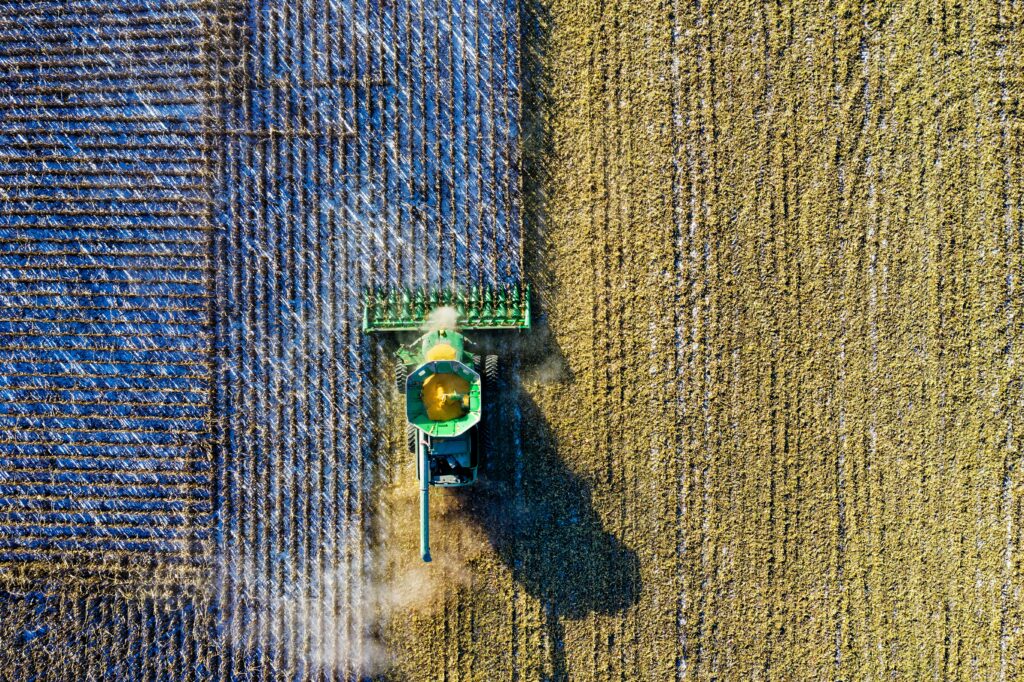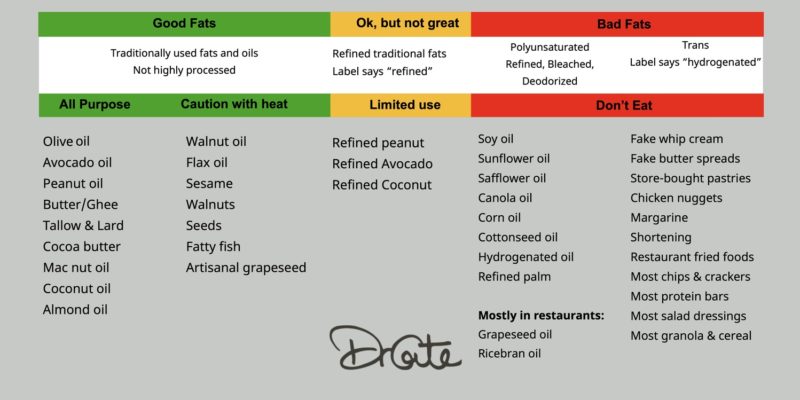Fresh food, straight from the land, straight from the area where it’s grown, is vitally more important than unfresh food in any form. Also, it begins to come into a vision biodynamically that the air of an area, the atmosphere, produces the soil, produces the locale, and that the fruits and the vegetables that will and do grow in that area belong to the people who live and breathe and emanate in that area…
…Even your own egg from your own hens is quite different to any one that even a great personality would give you. If the president sent you some eggs, they couldn’t be better. But these, of course, are not just vagaries, they are considerable realities. And, very frankly, we do all have to admit that we’ve a great deal forgotten what fresh food and fresh fruit is.
Alan Chadwick – Villa Montalvo Lecture Series – 1972
Human Digestion And Nutrition
1.1 Biodynamics thinking understands nutrition in a very different way to mainstream nutritional thinking. The two main concepts that I took from the nutrition course, were the importance of force/life energy within the food we are eating, and also widening the concept of nutrition beyond what we put in our mouths, to include our environments, the cosmos, and lifestyles.

Produce that is grown on a biodynamic holding is likely to be more nutrient-dense, and full of life force. The concept of eating foods full of life force is counter to a substance/material understanding. Supermarkets are filled with foods that are low in nutrients, and void of life force. The production methods for most foods in the supermarket are economical. Henk Kurt explained to us how a white supermarket loaf is made from grain to finished product within 2 hours, this will be harmful to our health, and will not provide us with the forces we need to remain in a state of health unless we have a strong digestive constitution able to metabolism such substance.
Below, I have outlined my basic understanding of nutrition which was greatly reinforced following the nutrition weekend at Ruskin Mill.
| Foods To Consume | Foods To Limit Or Avoid Altogether |
|---|---|
| Organic/Biodynamic Vegetables | Processed/Packaged Foods |
| A moderate amount of Organic/Biodynamic Meat | Refined Sugars |
| Organic/Biodynamic Offal/Bone Broth | A high amount of refined carbohydrates |
| A small amount of Fermented Food | Vegetable Oils (excluding olive, coconut, avocado) |
| Leafy Dark Greens | Re-heated food or Frozen Food |
| Foraged Foods | Alcohol |
Digestive process
(1.2) The diagram below takes us through the digestive process from a biodynamic nutrition perspective.

Roles of roots, leaves, fruits, flowers, and seeds relating to nutrition
(1.3) In lecture two of the agriculture course, Steiner speaks about the surface of the earth is likened to the human diaphragm. He later says compares the plant to the human body upside down, with the head buried in the ground.
When we perceive the human being upside down, then we can connect human organs, to the parts of plants. The nervous system, of the human, is the brain, while for the plant the roots fulfil this function. The lungs of the human upside down would equate to two leaves branching out above the topsoil. The flowers and fruit of the plant would then equate to the digestive system and reproductive organs.
Biodynamic nutrition makes a connection between the types of foods we eat, being beneficial to the different regions of the body. Not exclusively, but there may be a propensity. In this regard, biodynamic nutritionists would recommend that we include an element of roots, leaves, flowers, and fruit within each meal.
For example, drinking camomile tea would be beneficial to digestion.
| Fruiting Body | Beneficial For | Element | Threefoldness |
|---|---|---|---|
| Roots | Mind, Head | Earth Element | Thinking |
| Leaves | Respiration, Lungs | Water and Light Elements | Feeling |
| Flower | Digestive System | Warmth Elements | Willing |
| Fruits & Seeds | Reproductive System | Warmth Elements | Willing |
Factors contributing to food quality
Methods of assessing the quality of foodstuffs
(2.1) As a general rule, the higher the food quality, the higher the nourishment. Primarily, we can use our senses to conduct our own research into the quality of our food. We can quickly decern a carrot grown biodynamically, compared to a supermarket carrot grown out of season, packaged, and imported from a long way away. If a vegetable tastes dull or has no sense then it may be an indicator that it was grown using artificial enhancers.
By finding out the way in which the food was produced we can assess the quality of the food. Ideally, we should establish relationships with the growers producing our food, and also ideally they should be local to us. By sourcing our food at the grassroots level we can ensure that it is of the highest quality, and will be highly nutritious.
Supermarkets and global producers will have their own methods of assessing the quality of foodstuffs, but often from a materialistic world perspective, that avoids the notion of forces. There are many instruments that are able to measure data points in our food, mostly towards ensuring that food grown industrially is safe. In many cases, the scientific endeavour to make food safe, us with sterile food.
Together with the quality of the food itself biodynamic/organic food is produced with better humanitarian husbandry, and is also more likely to utilise sustainable packaging.

Attention to quality in the principles and practices of a local food enterprise
(2.2) In the recent edition of the Star & Farrow magazine, there has been a focus on food quality. An article called ‘Wheat, Bread and Food Quality’ Written by Rupert Dunn, caught my attention, in its relevance to the nutrition course, and this particular section.
Rupert makes the point that ‘striving for meaning and striving for quality may be intrinsically linked’ this resonates with me following the nutrition course, as we tried a salt & honey loaf that was baked by one of Henk Kurt’s friends. Great care was taken in making this loaf of bread, it was nutritious and tasty, no corners were cut, every ingredient felt like it was carefully sourced, and the quality of this bread was interwoven with its meaning.
If a food enterprise is lacking meaning in what they do, the quality will suffer. Many restaurant chains are focused on profits, and make foods that are very tasty (mostly due to hidden ingredients) but lack quality.
“If we can be the best possible custodians of life forces, our lives have meaning and we create quality, or quality is created as a result of our custodianship. With wheat and bread, this means we are in relationship to all the life forces available to us to produce our bread”
To produce quality food, we must consider everything that goes into making it. Through meaning, we can understand what is meant to be and what is not, as we strive for the idea. For example, could there be a difference between using tap water or natural spring water in the bread? Is the dough kneaded by machine or hand? Do we package the bread in plastic, paper, or reusable woven bags?
In the article Rupert Dunn, writes about the heat used to bake the bread, “We can choose a natural fire, with the full range of infra-red, heat released from wood as directly stored sunlight, rather than the reconstituted energy from electricity”.
Each decision made by a food enterprise moves them closer or further from the ideal. When feasible they should move towards the ideal, which is towards meaning, and thus quality. In the case of Rupert Dunn, the bread is enthused with meaning, from the selection of heritage grains to the milling of the grain in a peasant stone mill.
How do biodynamic methods have a positive impact on the quality of food?
(2.3) Biodynamic methods avoid any use of chemicals, such as Glyphosate. This chemical is an active ingredient in many herbicides used in modern agriculture, affecting all produce grown within this paradigm, from grains to vegetables. Ben Greenfield writes: “research has implicated glyphosate exposure in various systematic disorders: it suppresses the biosynthesis of cytochrome P450 enzymes and amino acids by gut microbes, directly damages DNA, disrupts glycine homeostasis, inhibits succinate dehydrogenase, affects the chelation of minerals such as manganese, changes natural biological compounds to more carcinogenic molecules, and disrupts fructose metabolism, all of which significantly impact metabolism and lower immune functions.”
I can only comprehend a few of the complex biological effects that Glyphosate has on the human organism, but it is important to list them so we can make more informed decisions about our diet, as the value of organic/biodynamic food vs non-organic food is highly misunderstood in our culture, partly due to economic reasons, but also a misunderstanding of the potential health implications.

Social, Cultural, and Economic Factors Influencing Food Consumption and Wellbeing
Analyse patterns of food consumption within groups
(3.1) It’s apparent that different groups of people have different food consumption habits. In fact, every individual will have their own preferences and patterns of food consumption. Religious, the activist, economic, social, and political, are some of the possible groups.
Many religions have specific days fasting days or periods such as Ramadan for Muslims or New Moon fasting for many practising Hindus. Different religions also restrict certain foods, Hindus are forbidden to eat beef, and Muslims and Jews are forbidden to eat pork.
Veganism and vegetarian diets are likely to be adopted for ethical reasons, such as animal welfare, and climate change.
Some groups eating habits are dictated by health, these groups may have researched nutrition and now follow diets such as the ketogenic diet, a gluten-free diet, a paleo diet, or any other diet depending on what has influenced them or the media that they consume.
The cost of living influences consumption habits, although some groups may prioritise good food over other expenses. In the past, food was our biggest expense, but today many groups would save money by buying poorer quality food, and spend their money on other things.
Impact of social, cultural, and economic influences on food consumption
(3.2) Food choices can be a very contentious topic. Many of us hold deep beliefs about which food to eat and which to avoid. We can easily become stuck within the mainstream paradigm unless we take conscious action to think about our food. I was fortunate to travel, and volunteer on farms in Europe, which completely flipped my paradigm, and made me consider the consequences of eating heavily processed food. In our society, it is normal to eat heavily processed foods, refined carbohydrates, too much sugar, and toxic vegetable oils. Many of these harmful ingredients are hidden under different names, there are over 50 different types of sugars, from Dextrose, Barley Malt, to Fruit Juice Concentrate. Many vegans and vegetarians practice their diets for ethical reasons, such as animal welfare, or environmental reasons.

The cost of living can be a barrier to nutritious food for many people. Organic food is twice as expensive as non-organic food, and biodynamic food is likely to be more expensive still. Therefore, with little economic means, it can be more difficult to afford nutritious food. In terms of nutrient density then organic food will be seen to be more economical.
Brands and convenience have a huge impact on our choices about food. Macdonalds and Coca Cola have sponsored every FIFA World Cup tournament that I have watched, even though these brands are addictive, and have a clear negative influence on our health. No conscientious athlete would be eating these foods, yet they are able to advertise to millions of children at every one of these emotive world sporting events.
The influence of advertising on our food choices is striking. Today, we are bombarded with advertisements for nutrient-void food every single day and are psychologically susceptible to the highly researched tricks, and micro-nudges of the food industry’s marketing arm.

We pay a lot for convenience in our culture. Ready meals have a dedicated aisle in most supermarkets. Where a single portion of a pre-cooked, processed, and force a devoid meal, packaged in plastic is sold and bought by consumers for £2-4. If the consumer planned meals in advance and was able to buy whole foods in bulk, then there is the potential of saving money and eating more healthily.
The human body doesn’t regard all calories as equal. But this is a great food myth that seems to have penetrated deep into society, still gaining traction. From April 2022, all cafes and restaurants will have to label their menus with calories.
This misguided nutritional belief may be doing more harm than good. Is 200 calories of salmon, the same as 200 calories of crisps? On the Intelligence Squared Podcast, Tim Spector, and Dan Saladino, discuss the origins of food myths our society believes in.
Following World War II, there were major food shortages across Europe, and other parts of the world. This led to millions dying of malnutrition. The food industries at the time devised new foods based on the poor nutritional science of the time. They managed to save lives, by creating cheap foods quickly, but ultimately these food are harming us now, in times of great abundance. The British Cheese industry was almost wiped out, as everyone decided to make Cheddar, as it was the most calorific. It was only importing French cheese in more recent times, that has re-awakened British artisanal and local cheeses.
Review and revise your own consumption of healthy/unhealthy foods.
(3.3) Last year I read the book: Deep Nutrition: Why Your Genes Need Traditional Food, By Catherine Shanahan. Overnight this book changed my eating habits, although I have regressed back to a less healthy diet over the year.
The book lists four pillars of health, fresh vegetables, meat on the bone, organ meats, and fermented foods. I have been trying to incorporate these food groups into my diet as often as possible. Eating this way is more costly, as the ideal is to source these foods organically, and biodynamically grown.
The damage caused to the body by vegetable oils was the most startling discovery in the book. I have dedicated a lot below to vegetable oils because I believe it to be a very important issue. Recently, more and more people are eating dairy/meat replacement foods, and are unaware of the concentration of vegetable oils in these products, or the potential dangers.
“Years of consuming these high-PUFA seed oils has a consequence that almost nobody is talking about just yet. Our body has no choice but to store the extra PUFA in our body fat, and that means that over decades the concentration of PUFA in our body fat gradually rises. Back in the early 1900s our body fat PUFA percentage was 2-4. Today it’s 10-30%. This makes our body fat prone to inflammation and has disastrous consequences for our overall health and ability to fuel our cells.” – Dr Catherine Shanahan
It’s remarkable how vegetable oils have infiltrated most of the products in the supermarket, if it comes in a package the chances of containing vegetable oils is very high. It’s in everything, even olive oil that’s traditionally used in humus has been substituted for the cheap alternative sunflower oil.

Below, is a video from a content creator on YouTube that I find very informative. In the video he timeframes the introduction of vegetable oils into the western diet. He explains that the first heart attack documented in a medical journal happened in 1912, just as vegetable oils were entering the American diet, and in 1948, the owners of Crisco gave a lot of money to the American Heart Association.
I know that I’m eating excess amounts of sugar. During tea breaks at Ruskin Mill, I eat too many biscuits that I could replace with something much more nutritious. After the nutrition course, I made a deal with a colleague that whoever eats the next biscuit during working hours, would have to pay the other a considerable fee. After two weeks of this wager, neither of us has given in, and I think it will last for a long-time. Since this deal was made I am no longer craving biscuits.
I believe one of the best ways to eat more nutritiously would be to boycott supermarkets. By doing 90% of food shopping at local markets, and farm shops. This would limit the amount of processed foods, and promote whole foods, vegetables, and meat. Realistically, boycotting the supermarket may increase the amount spent on food by two or three times, but that price truly reflects the labour of locally grown and raised food.
Bibliography
Recent Posts
Biodynamic Ecology and the Brain: How the Farm Organism Aids Neurodivergent Self-Regulation
The Farm as a Living Organism The Farm Organism is a fundamental concept within the biodynamic agricultural method, which began in 1924 with a series of eight lectures on agriculture by...
In February 2024, I attended the 100th biodynamic conference at the Goetheanum in Dornach, Switzerland. Here, biodynamic farmers, educators, winemakers, community leaders, and growers met to share...
